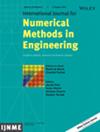An Energy-Conserving Time Integration Scheme for Nonlinear Dynamics Analysis of Geometrically Exact 3D Euler–Bernoulli Beams
Abstract
In the nonlinear large deformation regime, the beam theory is usually based on the Timoshenko assumption which considers shear deformations. The formulation of a 3D Euler–Bernoulli beam has been significantly delayed and only recently it did attract the attention of few researchers. The main reason lies in the challenging complexities met once an attempt to develop such a theory is undertaken. The main obstacle in defining a three-dimensional Euler–Bernoulli beam theory lies in the fact that there is no natural way of defining a base system at the deformed configuration. In this article, we provide a novel methodology to do so leading to the development of a spatial rod formulation which incorporates the Euler–Bernoulli assumption. The first approach makes use of Gram–Schmidt orthogonalisation process coupled to a one-parametric rotation. The latter completes the description of the torsional cross sectional rotation and overcomes the nonuniqueness of the Gram–Schmidt procedure. In a second approach, the rotation tensor is defined based on first and second derivatives of the displacement vector of the centre line. It is followed by one parametric rotation. The proposed formulation is extended to the dynamical case and a stable, energy and momentum conserving time-stepping algorithm is presented as well. Specifically, the proof of conservation of angular momentum of the time stepping algorithm is highly demanding and is given here in full.

 求助内容:
求助内容: 应助结果提醒方式:
应助结果提醒方式:


